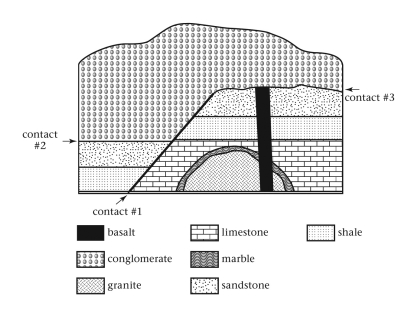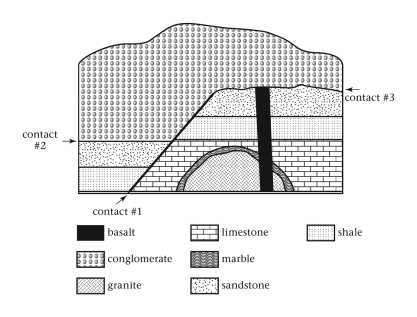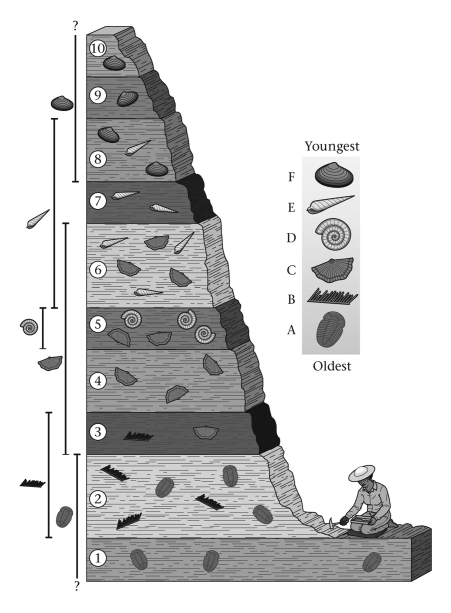A) granite
B) marble
C) limestone
D) sandstone
F) A) and C)
Correct Answer

verified
Correct Answer
verified
Multiple Choice
Why is radiocarbon dating only rarely applied in geological work?
A) No substances on Earth contain significant amounts of carbon-14.
B) The half-life of carbon-14 is so long that it is effectively a stable isotope.
C) The half-life of carbon-14 is so short that it can only be used to date materials that are less than 70,000 years old.
E) A) and C)
Correct Answer

verified
Correct Answer
verified
Multiple Choice
Presented with an outcrop containing a succession of beds and only the knowledge of relative-age dating,which of the following would be the best to look for to determine the story of the outcrop?
A) a fossil that could be found in all of the beds
B) an intrusion, as it would be older than the surrounding rock
C) a fossil found in only a few layers
D) a fault, as it would be older than the surrounding rock
F) A) and C)
Correct Answer

verified
Correct Answer
verified
Multiple Choice
Why did James Hutton deduce that there must have been a long time before human history began?
A) He found no physical remains of humans in his geologic investigations.
B) No human had seen the full process of sediment deposition to mountain formation.
C) He found no signs of humans in the ancient rock record.
D) No human had observed continents in different locations.
F) C) and D)
Correct Answer

verified
Correct Answer
verified
Multiple Choice
If the lithology and fossil content of two bodies of rock on opposite sides of a canyon are identical,then these remaining outcrops were likely physically connected at one time and formed part of an extensive,sheet-like layer of rock.This idea summarizes the principle of ____________. 
A) superposition
B) original continuity
C) original horizontality
D) uniformitarianism
F) A) and C)
Correct Answer

verified
Correct Answer
verified
Multiple Choice
What principle allows geologists to deduce that folds in beds occurred after deposition?
A) principle of uniformitarianism
B) principle of superposition
C) principle of lateral continuity
D) principle of original horizontality
F) A) and D)
Correct Answer

verified
Correct Answer
verified
Multiple Choice
The surfaces named contacts #2 and #3 are examples of ____________. 
A) conformable sedimentary contacts
B) faults
C) baked contacts
D) unconformities
F) C) and D)
Correct Answer

verified
Correct Answer
verified
Multiple Choice
James Hutton,the "father of geology," put forth the principle of ____________.
A) superposition
B) original continuity
C) original horizontality
D) uniformitarianism
F) B) and C)
Correct Answer

verified
Correct Answer
verified
Multiple Choice
Which of the following always varies among multiple isotopes of a single element?
A) atomic number
B) atomic mass number
C) tendency to decay radioactively
D) None of the above are correct.
F) A) and B)
Correct Answer

verified
Correct Answer
verified
Multiple Choice
Which statement best summarizes the development of the geologic time scale?
A) Numerical ages for rocks were known well before the relative sequence of sedimentary layers was established.
B) Relative ages for sedimentary strata were known well before accurate numerical dates for these rocks could be provided.
C) Names of relative ages (such as Silurian) and accurate numerical dates for these ages appeared at about the same time.
E) A) and C)
Correct Answer

verified
Correct Answer
verified
Multiple Choice
Concerning the relative ages of the granite and sandstone,the ____________. 
A) granite must be older, according to the principle of superposition
B) sandstone must be older, according to the principle of superposition
C) granite must be older, according to the principle of components
D) Their relative ages cannot be determined from the information given.
F) A) and C)
Correct Answer

verified
Correct Answer
verified
Multiple Choice
Attempts to measure the age of Earth by extrapolating modern riverine influx rates into the past to produce modern marine salinity from an initially freshwater ocean failed to take into account that ____________.
A) salt is removed through precipitation, balancing riverine input
B) dissolved salts from weathering of rock only rarely are transported all the way to the ocean
C) salts derived from the weathering of rock are insoluble in water
E) None of the above
Correct Answer

verified
Correct Answer
verified
Multiple Choice
Uniformitarianism is succinctly summarized by which phrase?
A) The future is the key to the present.
B) The present is the key to the past.
C) The past is the key to the present.
D) The present is the key to the future.
F) All of the above
Correct Answer

verified
Correct Answer
verified
Multiple Choice
As understood by modern geologists,the principle of uniformitarianism implies that ____________.
A) Earth has always had the same basic appearance that it has today, with the distributions of ocean basins and continents identical to what we see today
B) igneous, metamorphic, and sedimentary rocks are uniformly mixed throughout the crust of Earth
C) physical processes observed today (such as erosion and volcanic eruption) have been active in the past and are responsible for the geologic history we see preserved in the rock record
D) physical processes observed today (such as erosion and volcanic eruption) have been occurring throughout Earth history at constant rates; for example, no eruption in geologic time would have been greater than the 1815 Tambora eruption
F) None of the above
Correct Answer

verified
Correct Answer
verified
Multiple Choice
If a geologist wished to date an outcrop of sandstone beds that he or she found,which of the following should they look for to yield a specific date?
A) a fossil known to have a wide geographic distribution and to have existed over a long range of time
B) a sedimentary layer constrained by igneous or metamorphic rocks
C) a fossil known to have a small geographic distribution and to have existed over a short range of time
D) a sedimentary layer cut across by a fault
F) A) and C)
Correct Answer

verified
Correct Answer
verified
Multiple Choice
Within the world's undisturbed sequences of sedimentary rocks,fossils ____________. 
A) are rarely, if ever, found
B) are randomly distributed
C) occur in an ordered sequence
E) A) and C)
Correct Answer

verified
Correct Answer
verified
Multiple Choice
Which proportion of a radioactive isotope is expected to remain in an unaltered (unreacted) state after the passage of three half-lives?
A) one-third
B) three-halves
C) one-eighth
D) one-sixth
F) None of the above
Correct Answer

verified
Correct Answer
verified
Multiple Choice
Two atoms of a single element that differ in number of neutrons are said to represent two distinct ____________ of that element.
A) isomers
B) isotopes
C) isotherms
D) atomic species
F) B) and D)
Correct Answer

verified
Correct Answer
verified
Multiple Choice
Precisely speaking,a measured radiometric age for a mineral crystal within an igneous rock denotes the amount of time that has passed since the ____________.
A) atoms within the crystal were part of a body of molten magma
B) crystal solidified
C) temperature of the crystal became equal to the Curie point for the mineral
D) temperature of the crystal became equal to the closure temperature for the mineral
F) All of the above
Correct Answer

verified
Correct Answer
verified
Multiple Choice
When radioactively dating a rock,which of the following would NOT result in an inaccurate age reading?
A) using weathered rocks
B) homogenizing the rock material
C) using all of the minerals present
D) using only the daughter isotopes
F) None of the above
Correct Answer

verified
Correct Answer
verified
Showing 41 - 60 of 60
Related Exams